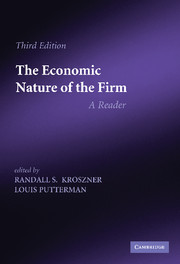Book contents
- Frontmatter
- Contents
- Editors' preface
- Reintroducing The Economic Nature of the Firm
- Part I Within and among firms: the division of labor
- 1 From The Wealth of Nations
- 2 From Capital
- 3 From Risk, Uncertainty, and Profit
- 4 From The Modern Corporation and Private Property
- 5 The use of knowledge in society
- 6 Corporate governance
- Part II The scope of the firm
- Part III The employment relation, the human factor, and internal organization
- Part IV Finance and the control of the firm
- References
1 - From The Wealth of Nations
Published online by Cambridge University Press: 05 June 2014
- Frontmatter
- Contents
- Editors' preface
- Reintroducing The Economic Nature of the Firm
- Part I Within and among firms: the division of labor
- 1 From The Wealth of Nations
- 2 From Capital
- 3 From Risk, Uncertainty, and Profit
- 4 From The Modern Corporation and Private Property
- 5 The use of knowledge in society
- 6 Corporate governance
- Part II The scope of the firm
- Part III The employment relation, the human factor, and internal organization
- Part IV Finance and the control of the firm
- References
Summary
Of the division of labour
(From book I, chapter 1)
The greatest improvement in the productive powers of labour, and the greater part of the skill, dexterity, and judgment with which it is any where directed, or applied, seem to have been the effects of the division of labour.
The effects of the division of labour, in the general business of society, will be more easily understood by considering in what manner it operates in some particular manufactures. It is commonly supposed to be carried furthest in some very trifling ones; not perhaps that it really is carried further in them than in others of more importance: but in those trifling manufactures which are destined to supply the small wants of but a small number of people, the whole number of workmen must necessarily be small; and those employed in every different branch of the work can often be collected into the same workhouse and placed at once under the view of the spectator. In those great manufactures, on the contrary, which are destined to supply the great wants of the great body of the people, every different branch of the work employs so great a number of workmen that it is impossible to collect them all into the same workhouse. We can seldom see more, at one time, than those employed in one single branch.
- Type
- Chapter
- Information
- The Economic Nature of the FirmA Reader, pp. 35 - 45Publisher: Cambridge University PressPrint publication year: 2009
- 11
- Cited by



